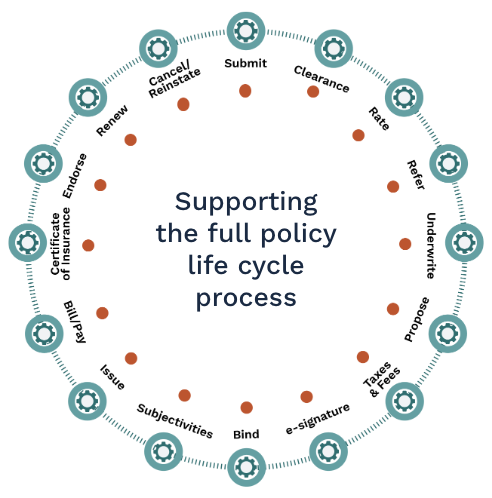There are a lot of dynamic forces at work in the insurance sector, but few are as significant as embedded insurance.
By 2030, the embedded insurance market could exceed $70 billion in the United States alone.1 The global market could reach three trillion by the same time.2For traditional carriers, embedded insurance holds both tremendous opportunity and noteworthy risk. On the one hand, you have a thriving sales channel with high conversion rates and access to deep customer data. On the other hand, there are significant operational and customer interaction considerations.
These reasons are why we’ve named it one of the most important policy administration trends in 2024. Download the full report here to learn more.
To help you better prepare for embedded insurance, this article will cover:
- How embedded insurance works
- Why it’s growing so rapidly
- How insurers can adapt
What exactly is embedded insurance?
Embedded insurance is the sale of any insurance policy during the transaction process of another product or service.
When you purchase rental insurance while renting a car, that’s embedded insurance. When you buy tickets from StubHub and pay to protect them in case you lose them, that’s embedded insurance.
While it’s enjoying a meteoric rise in popularity, embedded insurance isn’t new. In the 1960s, it wasn’t uncommon for Americans to purchase life insurance policies from airport vending machines.3
Modern examples include insurance policies from major automakers like Tesla, Ford, and GM. Consumers can complete the entire process—from quote to payment—within the automaker’s platform while they purchase a vehicle.
Distribution models
In practical terms, embedded insurance can be deployed in three ways4:
- Noninsurers act as a distribution partner to insurers
- Noninsurers act as an MGA and handle part of the value chain
- Noninsurers assume “full risk” and assume all of the responsibility
Traditional carriers need to think carefully when vetting potential partners. Yes, customer acquisition can be significant, but you must be careful not to give away too much control.
Why is embedded insurance growing?
There are two primary market forces powering the rise of embedded distribution:
- Consumer buying habits
- Increased insurer data capabilities
1. Consumers like embedded insurance
It’s no secret that shopping for insurance can be complex—sometimes even arduous. Embedded insurance has been around for a while, but it failed to catch fire because the customer journey was too fragmented.
However, the digital transformation of the customer experience (CX) has consolidated the disparate steps of choosing a policy into a streamlined experience. Rather than putting the burden of research on consumers, embedded insurance simply provides coverage options at the point of sale—the moment when people are most invested.
The simplicity of the experience is refreshing, and it puts the customer first by making it as easy as possible to get a quote and choose coverage.
2. Data and automation enable faster time-to-value
Data plays a fundamental role in this process. Without advanced analytics and automation, it wouldn’t be possible to provide customized quotes with the speed required at the point of sale.
Data analytics and automation improvements have made this kind of customer experience possible at scale. By analyzing data the customer is already providing during the purchase process, modern policy administration systems can generate personalized options for each customer.
The data advancements go beyond the point of purchase. For example, sensor data can give insurers an in-depth view of consumer behavior. This added context makes risk analysis and pricing more accurate.
Sensor data isn’t just for insurers; it also benefits the customer. Many of the coverage options automakers provide incentivize consumers to drive safer by offering lower premiums for responsible driving practices.
The sensors in the vehicle track how each person drives, and the safer the driver, the lower their premium.
How property and casualty insurers can adapt
Property and casualty insurers are particularly well-positioned to capitalize on embedded channels. Unlike health insurance and other complex coverages, P&C policies are more predictable and better suited for distribution through embedded channels.
Here are a few major ways P&C carriers can start planning for embedded insurance:
Negotiate partnerships carefully
While embedded insurance has significant growth potential, that opportunity doesn’t come without risks.
By offering products through a third party, insurers risk losing the chance to build relationships with new customers obtained through this sales channel. In a commoditized market, that’s a substantial risk.
However, there are ways for insurers to avoid being relegated to a “capacity provider” for noninsurers4. Design choices during the customer journey make a big difference.
For example, you can insist on having your branding visible during the customer experience instead of settling for a “white labeled” offer that doesn’t mention your organization. When customers submit claims, having the process run through your branded CX is another opportunity to build rapport and provide value directly to your audience.
Prioritize the customer experience
Of the risks related to offering embedded products, not participating might be the greatest. This distribution channel is growing rapidly because it puts the customer first. And industry data paints a clear picture of just how vital customer satisfaction is.
In a survey of 8,500 insurance customers, McKinsey found high scores in customer experience had a “direct link to value creation.”5
Here are a few data points to showcase what an advantage CX can be:
- P&C CX leaders outperformed their competitors by 65% in total shareholder return (TSR) over a five-year period5
- Customer experience leaders also had stronger revenue growth, lower expense ratios, and higher employee satisfaction5
Embedded products make the act of purchasing insurance significantly more convenient. The experience is almost seamless, a significant customer satisfaction driver.
When discussing how and why to launch embedded products, remember to always keep the customer in mind.
Bolster your technology capabilities
Embedded products rely on rich data insights derived from a variety of sources. APIs play a critical role in relaying this data to core systems and from those systems to the platform users interact with.
Whether you’re on a legacy system, using microservices, or in the middle of transitioning, boosting your technological capabilities is critical to delivering viable embedded product offerings.
Prepare your systems for embedded insurance
The way customers buy insurance is changing and insurance providers' need their technology assets to keep up with these evolutions.
Solartis can help. Solartis Insure is an API-centric, cloud-based Policy Administration Platform built on a state-of-the-art microservice architecture. It comprises over 150+ microservices that can be used as a full policy administration platform, rating system, for Carriers, MGAs, Embedded Insurance Providers, Agents and Insureds Its individual services can be seamlessly integrated (via APIs) with the customer’s existing technology platforms.
The platform operates on headless microservices, offering the flexibility to support various user interfaces and user experiences (UI/UX). This means that different stakeholders in the insurance process—be it Carriers, MGAs, Embedded Insurance Providers, Agents, Brokers, Insureds, or other Distribution Partners—can each have a tailored UI/UX, portal, or app that is specifically designed to meet their individual needs. In addition, Solartis assigns distinct permissions for each user type, regulating their access to certain functionalities and data.
A major advantage of headless microservices is their capability to decrease maintenance work and reduce expenses. One way this is accomplished is by having one set of underlying policy administration services that support all user types and distribution channels.
Schedule some time with one of our experts for a free technology assessment.
Sources
1 PRNewswire, Embedded Insurance Distribution Could Exceed $70 Billion By 2030
2 LinkedIn, Embedded Insurance: a $3 Trillion Market Opportunity
3 Insurance Business, Whatever Happened to Airport Insurance Vending Machines?
4 McKinsey & Company, Embedded Insurance and How Insurers Can Benefit
5 McKinsey & Company, Elevating Customer Experience: A Win-Win for Insurers and Customers



